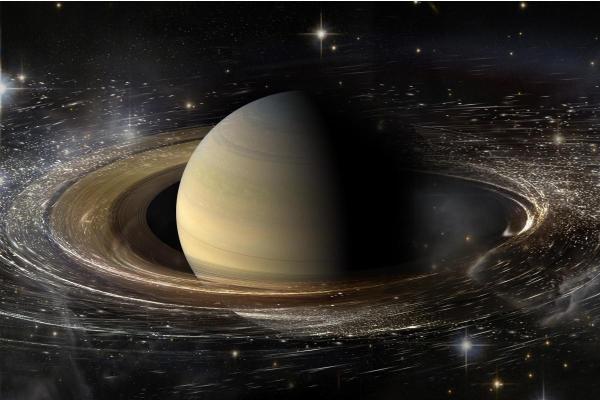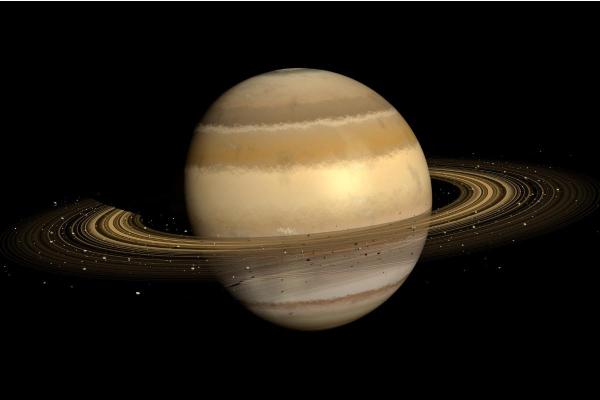
Saturn, recognized for its prominent ring system, has held human interest for centuries. Early astronomers observed it with rudimentary telescopes, while modern missions like Cassini have provided detailed data, deepening our understanding of this gas giant. Today, Saturn remains a cornerstone of planetary research, offering insights into the formation and dynamics of our solar system.
In this article by thedailyECO, you’ll explore ten key facts about Saturn, from its turbulent atmosphere and fascinating internal structure to its diverse collection of moons.
Its rings are icy
Saturn is known for its prominent ring system, one of the most striking features of our solar system.
These rings consist primarily of ice and rock particles, varying in size from dust grains to house-sized chunks, and even some larger objects. Though they appear solid from a distance, they are composed of individual particles orbiting Saturn.
The main rings extend 282,000 kilometers (175,000 miles) in diameter, yet average only about 10 meters (30 feet) in thickness. This vast but thin structure is a key characteristic. The rings have complex structures, including waves, ripples, and spokes, due to gravitational interactions with Saturn's moons.
Scientists believe Saturn's rings are relatively young, possibly forming within the last few hundred million years. The leading theory suggests they originated from shattered moons, comets, or asteroids disrupted by Saturn's gravity. These icy bodies came too close to the planet and were broken apart by tidal forces. The particles are mostly ice, with dust and other materials.
The rings' appearance changes as Saturn orbits the Sun. Due to Saturn's tilt, we sometimes see them face-on, and other times edge-on.
Saturn's rings are a complex system. Discover the ongoing debate surrounding their exact number in our related article.

Its surface is nonexistent
Saturn is a gas giant, lacking a solid surface like Earth. It is primarily composed of hydrogen (about 96%) and helium (about 3%), with traces of methane, ammonia, and water vapor. It is the second-largest planet in the solar system, after Jupiter, with an equatorial diameter of approximately 120,536 kilometers. For reference, this is about 9 times Earth's diameter.
Despite its size, Saturn has a low average density of 0.687 g/cm³, less than water. This is because Saturn is almost entirely gaseous. However, deeper within the planet, pressure and temperature increase, compressing hydrogen into a liquid metallic state. This core, though small relative to the planet's overall size, contains much of its mass.
Its density is less than water
As previously mentioned, Saturn's average density (0.687 g/cm³) is less than that of water. This means that, theoretically, if a sufficiently large ocean existed, Saturn would float.
However, despite its low overall density, Saturn possesses a dense core composed of rock and ice. This core is estimated to have a mass 10 to 20 times that of Earth. This dense core is surrounded by a vast envelope of metallic hydrogen and gaseous hydrogen.
This large envelope distributes the planet's mass over a much greater volume, resulting in the low average density we observe. This composition explains how a planet so large can be less dense than water, as mentioned before.
Its winds are ferocious
Saturn's atmosphere is characterized by extreme winds, far exceeding hurricane speeds on Earth.
In the upper atmosphere, these winds can reach velocities of up to 1,800 kilometers per hour (approximately 1,100 mph). For comparison, the strongest hurricanes on Earth rarely exceed 300 kilometers per hour (approximately 185 mph).
Its seasons last years
Saturn's seasons are remarkably long compared to Earth's. Because it takes Saturn about 29.5 Earth years to orbit the Sun, each of its four seasons lasts approximately 7.3 Earth years. This extended orbital period, combined with its distance from the Sun, creates a vastly different climatic rhythm than we experience on Earth.
Like Earth, Saturn has an axial tilt (about 26.7 degrees, similar to Earth's 23.5 degrees). This tilt causes seasons as different hemispheres are exposed to varying amounts of sunlight throughout its orbit. However, due to Saturn's slow orbit, these seasonal transitions occur much more gradually than on Earth.
Its North Pole is a hexagon
One of Saturn's most enigmatic features is the large, hexagonal cloud pattern at its North Pole. This hexagon is a massive jet stream flowing in the planet's upper atmosphere.
Its nearly perfect geometric shape makes it unique in the solar system. The hexagon spans approximately 30,000 kilometers (18,600 miles) across. This means that approximately 2.35 Earths could fit across the diameter of Saturn's hexagon.
We've seen how Saturn has its own unique "river of wind" at its North Pole. Want to learn more about these powerful atmospheric currents and how they form on other planets, including Earth? We explore the phenomenon of jet streams in another article.
Its largest moon is bigger than Mercury
Saturn is accompanied by a large number of moons. Currently, 146 moons have been discovered and officially named, with the possibility of many more smaller moonlets existing within its ring system. These moons vary significantly in size, shape, and geological activity.
Titan, Saturn's largest moon, is a particularly notable example. With a diameter of 5,149.5 km, it is larger than the planet Mercury (4,880 km in diameter) and is the second-largest moon in the solar system, second only to Jupiter's Ganymede (5,268 km).
Titan is unique for several reasons. It possesses a dense atmosphere, primarily composed of nitrogen (about 95%) and methane (about 5%), with traces of other hydrocarbons. This atmosphere creates a hazy orange appearance. Furthermore, Titan has stable bodies of liquid on its surface, including lakes, rivers, and seas composed of liquid hydrocarbons like methane and ethane. This makes it the only known celestial body in our solar system, besides Earth, with stable surface liquids.

Its has an internal heat source
Saturn radiates more energy into space than it receives from the Sun. This excess energy is generated by internal processes, primarily through the slow gravitational compression of its core and, uniquely to Saturn among the gas giants, a process called "helium rain."
Within Saturn's interior, helium condenses into droplets and falls inward, releasing heat as it descends. This internal heat source makes Saturn a dynamically active planet. It emits about 1.8 times more energy than it absorbs from sunlight. Learn more about the star at the center of our solar system and its internal layers in another article.
Its rings are disappearing
Saturn's iconic rings are not a permanent feature. They are gradually disappearing due to a process called "ring rain." This phenomenon involves icy and dusty particles from the rings being drawn into Saturn's atmosphere by a combination of factors: gravity, Saturn's magnetic field, and the solar wind.
The process begins with micrometeoroid impacts and ultraviolet radiation from the Sun striking the ring particles. These impacts and radiation can vaporize water ice and create water ions. Saturn's magnetic field then interacts with these ionized water molecules, pulling them along magnetic field lines toward the planet.
Once in Saturn's upper atmosphere, these particles are neutralized and fall as a sort of icy rain. This "rain" isn't uniform across the rings; some areas are losing material faster than others. Scientists estimate that the rings could disappear entirely in a few hundred million years, which, while a vast timescale for humans, is relatively short in astronomical terms.
Saturn's rings are iconic, but they're not the only rings in our solar system. Explore the ring system of Neptune and see how they differ in our other article.

Its has methane clouds
Saturn's atmosphere exhibits complex and dynamic weather patterns, unlike those found on rocky planets. Interactions between winds, clouds, temperature, and pressure create constantly shifting cloud formations.
While Saturn's lower clouds are primarily composed of ammonia and water ice, the upper atmosphere hosts methane clouds. These form as methane vapor and other gases condense in the cooler upper layers, creating a mixture of fog and powerful thunderstorms. These storms can be massive, spanning thousands of kilometers. The dynamic nature of these clouds, along with the high-speed winds previously discussed, contributes to Saturn's ever-changing atmospheric appearance.
If you want to read similar articles to Fun Facts About Saturn's Rings and Moons, we recommend you visit our Facts about Earth and the universe category.
- Introducing Saturn. Questions, Answers, and Interesting Things to Think About. NASA (National Aeronautics and Space Administration). Available at: https://www.jpl.nasa.gov/_edu/pdfs/jss_minibook_introducing-saturn_spanish.pdf
- Parra Chaparro, PA, Curiosities of Saturn. Scribd. Available at: https://es.scribd.com/presentation/485972653/curiosidades-de-saturno-1